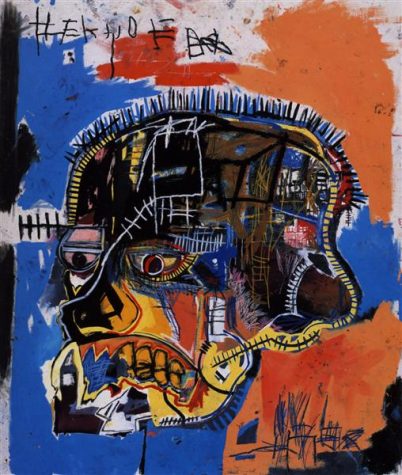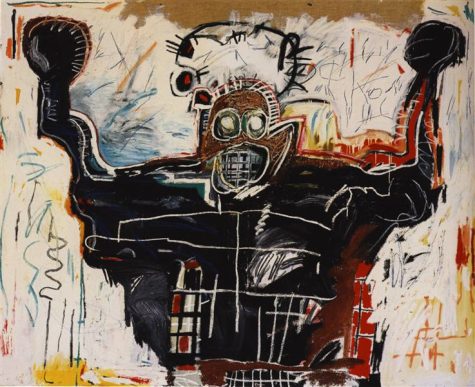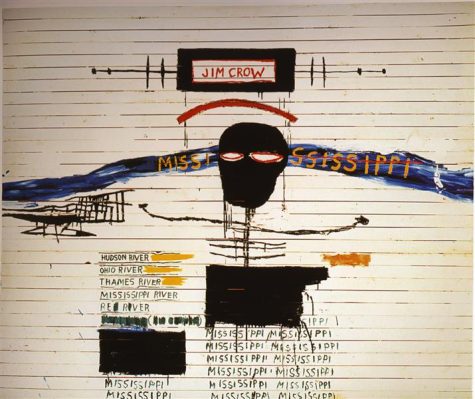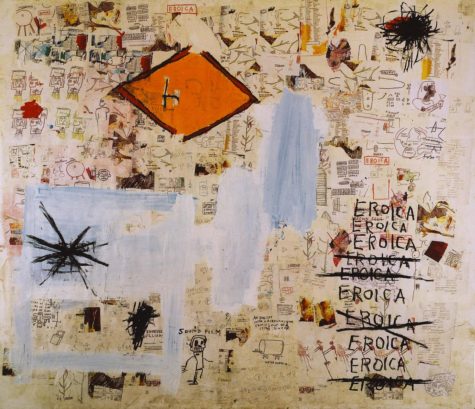Who was Jean-Michel Basquiat?
February 6, 2023
Who was Jean-Michel Basquiat?
Few artists (through any medium) had as much impact, influence, and an artistically luminescent soul as Jean-Michel Basquiat. Born in Brooklyn to a Haitian father and a Puerto Rican mother, Basquiat would become the face of modern street art (namely graffiti) alongside contemporaries like Keith Haring and Futura 2000, but neither of them shook the art world like Basquiat did, justifying his place as the face of black artists during Black History Month.
Mini-Bio
Beginning with the ‘‘SAMO’’ works (which was an inside joke between him and a high school friend), Basquiat mostly employed his skills within the streets of Manhattan, spraying art that was not only artistically challenging for the time, but socially expressive as well (as he grew up in the Civil Rights era). As time went on, his works became more and more expressive, as he experimented with different concepts in sociology (police brutality, drug abuse, black oppression) as well as different artistic choices. This was most prominent in his collaborations with the late Andy Warhol, as one of Warhol’s most famous (and controversial) pieces was a screenprint of Basquiat with a slight hint of urine. In Basquiat’s works, a mixture of painting, poetry (or other text), social commentary, and the soul of a man who lived and breathed art were all present. Sadly, his breath was cut short in the summer of 1988, as Basquiat passed away due to his infamous overdosing of heroin. He struggled with drugs the more he grew in fame, which would lead to his ultimate demise. In this respect, his art has an inverse relationship, as the worth of his pieces skyrocketed.
Influence
Basquiat created some of the most important pieces of art during the 20th century, yet so few museums display his work. This is the result of private buyers hoarding (or privately exhibiting) them, as they were all mostly acquired before his demise, and if not, were acquired by extremely wealthy individuals to invest and privately own. Nonetheless, his pieces have acquired critical acclaim worldwide, which is directly found through the hundreds of thousands of people influenced by his work in several mediums of art and culture itself. Although his art was of general social commentary of his time, the waves of these issues continue today, allowing his works to remain timeless in the face of social injustice, especially against African American communities. Outside of the dozens of ‘‘replica’’ artists who use a very similar style, his influence has reached into other mediums of art, specifically music. Much of hip-hop has been influenced by the work, ideas, and personality of Basquiat. As he was influenced by the works of Nina Simone, John Coltrane, and David Bowie, rappers like Kanye West, A$AP Rocky, and Lauryn Hill have namedropped and been directly influenced by the works of Basquiat. This is even noticeable with the release of The Stroke’s latest album ‘‘The New Abnormal’’, featuring a Basquiat work as its cover (‘‘Birds on Money’’, 1981).
Showcase
His art itself is of a graffiti/canvas mixture, nearly revitalizing the early 20th century ‘‘primitive’’ art style with the backdrop of neo-expressionist techniques for a truly urban display of emotion (usually frustration, anger, or confliction). He tackled several social themes of racism, death, drug abuse, and similar concepts.

‘‘Untitled Skull’’ (1981)
This piece was created in a way that almost depicts a head half-opened and half-closed, as the Frankenstein-like stitches are reminiscent of a sort of procedure that would have been done. This is supported by the ‘‘downed’’ look on the face of the skull, as it seems indifferent, contrasting with the vivid expression found inside the head of the skull and the background of the art (again, reminiscent of early-20th century ‘‘primitivist’’ art pieces). This piece currently resides in ‘‘The Broad’’ in Los Angeles.

‘‘The Boxer’’ (1982)
This piece depicts a black boxer with both arms raised. His face is in a signature Basqiaut style, reminiscent of a morphed skull. The background is painted with graffiti marks scattered against the white backdrop of the piece. It seems to be a piece displaying a sort of triumph (as most boxers usually pose like this after the K.O. of their opponent). Basquiat seemed to have an interest in the sport of boxing, as his famous photoshoots with Andy Warhol in a boxing uniform would support such. The seeming ‘‘halo’’ found above the disfigured face of the boxer grants a juxtaposition of the humanity (which may have been lost for such triumph) and hellish subtext, which is a recurring theme throughout several other paintings of his, specifically the next one. This piece resides in a private collection (previously resided in the collection of ‘‘Metallica’’ drummer Lars Ulrich).

‘‘Profit 1’’ (1982)
Similar to the previous piece, this artwork displays a figure (debated between being a shaman, self-portrait, or both) with both of its hands up and has its face outlined in white. Above his head, a spiked halo (or crown of thorns) is featured against a black background with an amalgamation of scribbled text and what seems to be a time/date nearing the bottom-middle of the piece. How both of the figure’s hands are raised is reminiscent of Picasso’s ‘‘Bombing of Guernica’’, an artist that was of heavy influence on Basquiat. This piece currently resides in a private collection.

‘‘Jim Crow’’ (1986)
This artwork, as the title suggests, displays an incomplete figure against the backdrop of what looks to be a mugshot being taken (this is a result of the wooden canvas colored white used to create the painting). ‘‘Mississippi’’ and several rivers are named, as a depiction of the Mississippi River seems to flow across the background. This can be symbolism for how both the river and Jim Crow laws separated the United States, geographically and socially. This piece currently resides in a private collection (sold for $17 million in Paris, the highest price for a Basquiat piece in France).

‘‘Eroica’’ (1988)
This piece is a result of the death of longtime friend Andy Warhol. One can see Basquiat going through the grieving process through the erratic style of the piece (especially in the background) as well as his thinking about his mortality (which is poetic considering this was the year in which he passed away). The phrase ‘‘Eroica’’ is repeated, referencing Beethoven’s symphony of the same name. This is the second piece in this series, as the first has a far more blank background but has the other phrase ‘‘man dies’’ repeated, echoing the message of mortality. In this piece, so many smaller messages, themes, and stories can be analyzed for hours on end yet they take up so little space individually. They patch together the background for one of his most artistically innovative pieces. It currently resides in a private collection.


